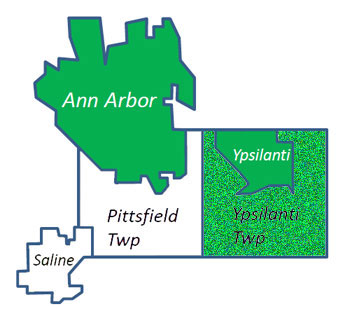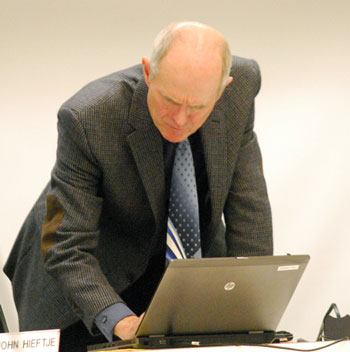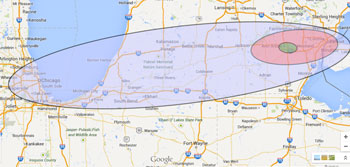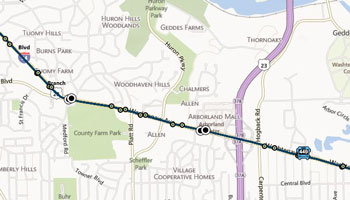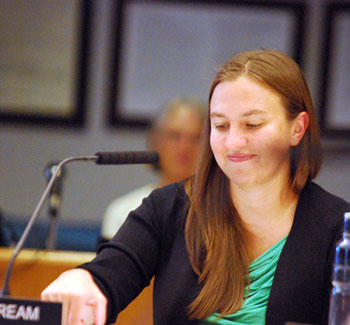Ypsi Township on Bus, DDA TIF Settled
Ann Arbor city council meeting (Nov. 18, 2013): The first meeting of the post-election council stretched 6 hours and 45 minutes past its scheduled start time of 7 p.m. It was not until after 1 a.m. that the council considered an agreement to sell a city-owned property north of William Street between Fourth and Fifth avenues in downtown Ann Arbor – to hotelier Dennis Dahlmann for $5.25 million. The council deliberated for about 10 minutes on that issue before taking a unanimous vote to sell.

Swearing in of the councilmembers who won election on Nov. 5, 2013. From left: Mike Anglin (Ward 5), Jack Eaton (Ward 4), Sabra Briere (Ward 1), Jane Lumm (Ward 2) and Stephen Kunselman (Ward 3). Administering the oath was city clerk Jackie Beaudry. (Photos by the writer.)
Earlier in the evening, an hour-long chunk of the meeting was taken up by deliberations on the admission of Ypsilanti Township as a member of the Ann Arbor Area Transportation Authority. After an hour of discussion and questioning, the council voted unanimously to approve the addition of the township as a member of the AAATA. The council’s action brought the number of AAATA member jurisdictions to three: the city of Ann Arbor, the city of Ypsilanti, and Ypsilanti Township.
The council also deliberated for almost an hour before giving initial approval to a repeal of the city’s crosswalk law – so that vehicles would have the option of slowing (in addition to stopping) to yield to pedestrians. The repeal also eliminates the explicit need for motorists to yield to pedestrians who are standing at the curb – making motorists responsible for yielding only to those pedestrians who are “within a crosswalk.” The repeal passed on a 9-2 vote, but will need a second vote at a future meeting to be enacted. Back-channel discussion of some kind of compromise approach has unfolded since the meeting, but it’s not clear what, if any, impact that might have.
On an issue related to the crosswalk ordinance change, 40 minutes was spent on council discussion on a pedestrian safety task force – which had been postponed from its Nov. 7 meeting. Ultimately the council voted to establish a nine-person pedestrian safety task force with a charge of delivering a report with recommendations by February 2015. Applications from interested citizens should be turned in to the mayor’s office by Dec. 2, 2013, with the task force members to be appointed on Dec. 16. [.pdf of standard city board and commission task force application]
The council also spent about a half hour deliberating on final approval to a change to the ordinance that regulates the tax increment finance (TIF) capture of the Ann Arbor Downtown Development Authority. The change replaced the restriction in the ordinance originally enacted in 1982 with one that in the next few years will result in about $2 million in additional TIF revenue annually, compared to the amount the DDA would have received under strict enforcement of the 1982 language. Dissenting on that vote were Christopher Taylor (Ward 3) and Margie Teall (Ward 4).
Near the start of the meeting, Teall was selected as mayor pro tem, on a 6-5 vote. The council left its other organizational business – adoption of rules and assignment to committees – until Dec. 2.
The members of the rules committee will have a fresh assignment based on other action of the council on Nov. 18. The council passed a resolution that in part directs the rules committee to develop a set of standards for the conduct of councilmembers, based on “applicable statutes, regulations, existing city policies, and best practices such as Section and 2a of Public Act 196 of 1973 and the Ethics Handbook for Michigan Municipalities.”
Other business handled by the council included the final approval of a revision to the city’s ordinance on park use fees – to allow for a waiver for groups using a public park for the charitable distribution of goods to address basic human needs. Council chambers were filled with supporters of that resolution.
The council also formally adopted an update to the city’s non-motorized transportation plan, after having postponed the item on Nov. 7. And as a part of its consent agenda, the council approved various street closings associated with New Year’s festivities – The Puck Drops Here in downtown Ann Arbor and the National Hockey League’s Winter Classic at Michigan Stadium. [Full Story]





